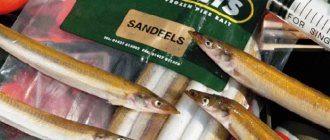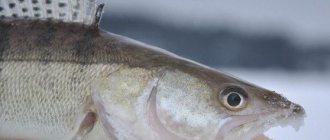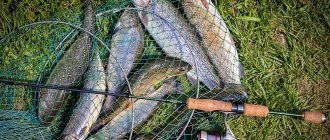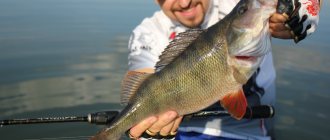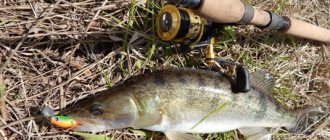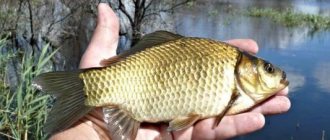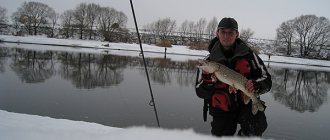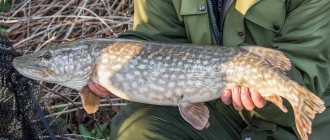Quite often you have to catch pike in muddy water. How difficult is it? Let's just say that such conditions seriously complicate the life of a spinner aiming to catch a predatory fish. At the same time, pike hunting is no exception. Catching it in muddy or dirty water is not only difficult, but sometimes impossible. However, there is no need to despair. Moreover, there is always a chance to succeed when fishing in such conditions. You just need to know and take into account some nuances.
There are rules for catching pike in a muddy body of water.
When is there muddy water in rivers, lakes and ponds?
You can fish for pike all year round. True, there are periods when fishing is more successful and when it is less successful. At the same time, one of the most difficult conditions for catching this river predator is muddy water. Ask why? Let's look into this.
First, let's find out when and why bodies of water become cloudy. Firstly, you should understand that for some rivers and lakes this is a completely normal condition. Especially for those that have a clay or sandy bottom. This type of soil means that even with a slight current, the water will become cloudy. Many water areas with muddy bottoms are also susceptible to this. After all, with a strong wind, the layers of water begin to mix. At the same time, all the bottom turbidity rises up.
It is worth paying attention to what waters feed the water area. For example, most rivers originate in the mountains, where snow can melt and glaciers melt almost all summer. Therefore, muddy water is not uncommon here. And throughout the year.
For many bodies of water, cloudy water is the norm.
When the water still becomes cloudy:
- During heavy torrential rains. Heavy precipitation carries various streams of dirt from the banks, tributaries and nearby territories, including soil particles, rocks, dust, etc.
- During the spring flood period. Melting snow and ice leads to changes in the ecosystem of all water areas. They get water that contains soil, lime, dirt, last year’s grass, garbage and much more that has “accumulated” over the long winter.
- During strong, prolonged winds. Especially those that blow across the riverbed (we are talking about a river). The water quickly becomes cloudy, and when the wind is directed from the larger water area to the smaller one. For example, from a lake to a creek. Strong wind currents form waves. Because of them, the water layers begin to mix. As a result, silt deposits, various debris, particles of dead algae, and much more rise from the bottom. etc.
Lures for catching pike in autumn
The main thing you should know when fishing for pike in the fall is what bait the pike prefers at this time of year, and this is very important. Remember this rule forever and every autumn you will catch your trophy:
Pike go out to feed in the fall and try to get as much food as possible so that the stored fat will last it throughout the winter. It follows from this that it is easier for a pike to catch a few large fish and get enough of it than to catch a hundred small ones and spend a lot of energy in pursuit of each of them. Therefore, to catch pike in the fall, you need to use large spinning baits, and the predator will be extremely reluctant to take small ones at this time of year.
In autumn you should have pike baits measuring 8-15 cm in length . At this time of year, there is no need to be afraid that a very large bait has been chosen. Now even a kilogram pike will grab such a large spoon or wobbler. In addition, it is in the fall that the probability of catching a large pike increases, and smaller baits will often catch the smallest pike - laces.
Now it is better to put aside spinners, which will not be as effective as in the spring, and switch to using large pike spoons, wobblers and silicone fish.
In the fall, the main role for pike is played by the size of the bait, and if it considers it too small to waste energy chasing it, then you simply won’t get a bite. The shape and color of the bait in the fall are less important for pike than in the summer, but sometimes it is easier to seduce pike with acidic colors when fishing in muddy water and with colors matching the color of a real fish in clear water.
September. The specific choice of bait will depend on the month of fishing and water temperature. The fact is that in September, while the water has not yet completely cooled down, pike stay in shallow water, along gently sloping shores, on spits and near thickets of reeds and vegetation. At this time, the ideal bait would be a wobbler with a shallow diving depth. During active pike biting, it is better to use baits of bright, poisonous colors or brightly contrasting ones. Red and white wobblers work very well in the fall.
October. Transition month. At the beginning of October, the pike will still be close to the coastline at shallow depths and wobblers will work perfectly again, but gradually the water temperature becomes lower and lower and the pike rushes to deeper parts of the reservoir - holes, dumps. Now it is best to catch pike with oscillating spoons and silicone fish on jig heads.
November. The final month of autumn pike fishing. The pike's appetite sharply declines and ends completely with the next cold snap. The pike begins to behave quite passively and is completely ready for a long winter. During this period, you also need to continue fishing with large-sized spoons and jigs, only the wiring should now be calmer, and the color of the bait should be closer to the natural colors of pike prey.
Recommended lures for catching pike in autumn
If you are still an inexperienced fisherman and pike are not in your catch as often as you would like, then most likely you have not yet decided on the best lures for catching pike and you will need help. Below I will present several baits that work flawlessly on pike in the fall. You can start with them so as not to waste precious time selecting bait, most of which may disappoint you.
Spinner Atom 2. A classic pike spinner that has been working on pike for decades and still few other modern lures can boast the same catchability. The ideal choice for catching pike is in October-November, when it has already moved to depth.
Classic colors are copper and silver. You can try both colors, but they usually work the same, although there is a slight dependence on the weather.
If you are lucky enough to get such a Soviet-made spoon, then good fishing is guaranteed. Now on the market there are mainly copies of this spoon, some of them work perfectly, and some are significantly inferior to the original.
Despite the abundance of advertised new products, this lure is a must-have in the arsenal of experienced pike anglers. And it often brings better results than wobblers and branded spinners that are significantly more expensive.
Wobbler Zip Baits Orbit 110 SP. And this is a modern bait. The wobbler is incredibly catchy, especially in the fall. The Zip Baits Orbit 110 SP can catch pike of any size and you should be prepared to bite both a line and a trophy specimen. Many fishermen try not to advertise this wobbler and not tell anyone about it, because its catchability is sometimes off the charts and you can use it to catch a couple of dozen pikes in a few hours. But I cannot keep silent about such an effective bait and I advise you to find and purchase this wobbler so that it lies in your bait box along with the Atom 2 spinner.
Works best in September-October. Moreover, all the colors in which the wobbler is produced are working. It works best when twitching with pauses.
It’s better to immediately take several copies in different colors, but it’s better to take the size 110. It showed the best results and it’s this kind of wobbler that will bring you a bite almost every second cast.
Vibrating tail Models from Mann`s and Relax. The cheapest and most catchy option is vibrating tails from Mann`s and Relax. They enjoy incredible success and popularity among both beginners and experienced fishermen, which undoubtedly confirms their good work.
It is important for the novice angler to know that using a jig head that is too heavy for a vibrating tail will make his action very harsh. That is, during the pause it will sharply sink to the bottom. And pike almost always grab the bait during pauses. Therefore, the pike, due to the sharp fall of the heavy bait, will often strike past it, not having time to grab the fast-sinking prey. Recommendation: do not use a jig head heavier than 16 grams and then the pike hits will be almost one hundred percent.
The optimal game is the classic step. But sometimes pike respond better to different combinations of retrieves. In any case, it is necessary to experiment with wiring directly on the pond in order to guess exactly the game that the pike will not be able to resist.
Here are some of the best lures of their kind that will serve you faithfully when fishing for pike. But you must understand that you need to learn each bait, understand it and learn how to catch it correctly. Some manage to catch the bait on the first cast, while others cannot catch the same bait even on the tenth fishing trip. A good bait is only half the success, the rest is up to you.
How pike behavior changes in troubled water
Poor transparency of the water areas where predatory fish are caught is a big obstacle to a good bite. The fact is that in such conditions she begins to behave differently - less active and even lazy.
Pike in muddy water are less mobile than in clear water
The same pike tries to stay in secluded places where, despite the muddy water, it can feel more confident. Therefore, the angler should remember:
- Pike practically do not stand in the coastal zone or on the current. In muddy water, it prefers areas with various shelters. These can be flooded trees and bushes, snags, thickets of water lilies (the main thing is that the depth is at least 1 m), as well as large stones and boulders lying at the bottom. In the presence of turbidity and poor visibility, pike also likes to hide near holes and depressions, since there are often gaps of clearer water here. Accordingly, it is easier for pike to hunt in such places.
- The fish tries to find the cleanest part of the reservoir. True, there are few of them. Especially during floods or heavy, prolonged rainfall. As a rule, this is the confluence of a tributary, some kind of deep-water channel, as well as areas where springs gush from the bottom.
- When the water is cloudy, the predator chooses places on the border of several currents. Such areas are not uncommon on many rivers. They usually form near creeks, as well as where different waters merge. For example, a river, and a stream flows into it.
In muddy water, pike stay close to various snags
- Both small squinting and large trophy individuals try to practically not move in muddy water. How do they feed? Usually food is always nearby. After all, as a rule, various “linen” (bleak, top melting, roach, etc.) are kept in the same places. It turns out that there is plenty of food for the pike. There is no need to look for it.
- The predator's attacks are very short! In muddy water, pike will not chase the bait for long. The maximum is a jerk over a distance of 1-2 body lengths. This is why there are usually so few bites when fishing in polluted waters.
Wobbler in muddy water
One of the negative factors affecting the activity of fish in a particular body of water is water transparency. Here, as they say, there is a double-edged sword. Too clear water is bad because it immediately increases the demands on the angler’s camouflage.
Too cloudy is also not good, because in conditions of limited visibility the predator, which will be discussed below, sees the bait worse. Activity in perch and pike in such conditions drops to almost zero.
A decrease in water transparency occurs at any time of the year and for various reasons. In the spring, when the snow just begins to melt, meltwater carries debris, sand and various clay inclusions into rivers and lakes; in the summer, after prolonged heat, they “bloom” into standing reservoirs; in the fall, the reason for this is long-term rains. Moreover, this happens in a limited period of time and is often detected already in the reservoir.
Muddy water. Quite a common phenomenon in our reservoirs.
It’s good if you can change the place by looking for cleaner places, however, if this is not possible, you have to adapt to the existing conditions and the first thing you need to do is change the range of baits offered. In conditions of limited visibility, the fish, along with vision, is guided by hearing and signals received by the lateral line. It must be said that some predators, such as pike perch and catfish, are sometimes even better caught in muddy water, since the places in which they are accustomed to living (depth, littered holes, etc.) imply this condition and provide an additional advantage in hunting - in muddy water it is easier to catch a gaping fry or frog by surprise.
Therefore, if the species composition of the reservoir suggests the presence of pike perch or catfish, and the time of year is suitable for catching these fish, you need to refocus on targeted hunting for them. Perch and pike, in this case, go into the category of “bycatch”.
The well-known saying “The water is muddy - fish from the bottom” perfectly characterizes the technique of fishing in muddy water. The main ones for catching any fish are sinking and deep-reaching wobblers, spoons and jig baits.
Duel Hardcore SH-50. Universal wobbler for all types of fish.
Since the visual factor has virtually no effect on the detection of a potential victim, the main quality that the bait should have is an active, aggressive game. The external similarity of the same wobbler with the food object is the fifth thing and is not particularly important. The main thing is that the vibrations created by it are as close as possible to those created by the fish when moving.
I must say that wobblers and spinners of various sizes cope best with this. Silicone baits, for all their versatility, create much less water disturbance, not to mention various “foam rubbers”. If, however, there are no other options, then the sizes of the above baits should be as large as the fishing rod allows. In this case, when, with the classic “step”, the bait touches the bottom, the necessary landmark for the predator is created due to the impact, and the increased volume and silhouette of a large vibrating tail is not the last moment for success. However, baits weighing more than 50 grams, which is what we are talking about in this case, require a certain spinning rod and a reel designed for jigging in the “heavy” format and are not always available at hand.
In most cases, you have to operate with a standard spinning rod and here, for such a case, you need to be equipped with special baits. As already mentioned, in addition to wobblers, you can get by with spinners. They, a consequence of their enormous prevalence and species diversity, are the most accessible remedy for muddy water. True, in addition to the obvious advantages, spinners also have their disadvantages. The first and main thing is the specificity of wiring these spinners, which does not allow stops and pauses. As already mentioned, the activity of any fish in turbid water decreases, and an object swimming by does not always provoke a predator to attack. This requires a game with freezing and fairly long pauses, i.e. something that only wobblers can provide.
In the conditions of our reservoirs, be it a river or a lake, the most versatile wobbler for fishing in muddy water, in my opinion, is the Duel Hardcore SH-50. This five-centimeter version in a bright green color scheme is excellent for catching pike, perch, chub, catfish and pike perch in almost all bodies of water I have been to. With a stated immersion depth of up to one and a half meters, on rivers with pronounced currents, this wobbler can be driven deeper. Although, as practice shows, it is not always possible to qualitatively fish holes deeper than two meters when fishing with a spinning rod using wobblers.
Perch on Duel Hardcore SH-50. Despite limited visibility, twitch-style wiring with pauses does not leave the striped robber indifferent.
Duel Hardcore SH-50 has all the necessary components for leisurely twitching. Two or three sharp jerks with the tip of the rod and a pause, during which this suspender hangs in the fishing horizon. Due to its small size, the use of leashes and bulky fittings turns it into a slowly sinking one, but this does not interfere with successful fishing. And the bright coloring and noise capsules add even more advantages when fishing in low visibility conditions.
When completing a set of baits, do not exclude the possibility of changes in the state of water in reservoirs and be sure to add something similar to your box. In this case, unexpected turbidity of the water in the fishing area will not affect the final result of fishing in any way.
Lures for pike in troubled waters
Now you know how the habits of a predator change. However, given the above, the question rightly arises: does pike bite in dirty and muddy water? Of course the answer is yes. Only the fisherman needs to carefully approach the choice of bait:
- It should create vibrations in the water that the pike can feel. The fact is that in such an environment the visibility of the bait is minimal. Therefore, the toothy predator often focuses more on the lateral line rather than on vision. So the priority is rotating and oscillating spoons. A pike can notice their “game” even at a distance of 15-20 m. Considering that you have to fish in muddy water, this is sometimes the only chance to interest its attention.
Fishing in muddy water requires careful selection of bait
- Lures should have a fairly bright color. For example, poisonous green, orange-acidic, red, etc. Sometimes white or light green wobblers and spinners perform well. Although pike in muddy water focuses more on catching vibrations with the lateral line, often at the last moment, seeing the bait and wondering whether to attack it, it also pays attention to the color.
- If you prefer wobblers rather than spoons, then you can catch pike in muddy water with cranks. Such baits resemble fish of bizarre shapes - with a round body and a short tail. Cranks are also capable of creating vibrations that are attractive to pike. And in completely different ways. In some models the head with the blade is more mobile, in others the tail part “plays”, in others the point of the center of oscillation is somewhere in the middle.
Should you use edible rubber when fishing for pike in water with low transparency? After all, such silicone baits, impregnated with fish oil and various attractants, have an attractive smell. Of course you can. However, it is in vain to expect that the fish will begin to attack the twister because of its aroma. The pike's sense of smell is poorly developed. This is not carp. Therefore, she practically does not use it when feeding.
You can catch pike in muddy water using cranks
It is also ineffective to treat baits with any flavorings. In conditions of poor visibility, the pike still tries to rely on its two main sensory organs - vision and the lateral line. Therefore, it is most effective to “spin” crankbaits on spinners, spinners and wobblers. And bright colors.
Noisy wobblers are also well suited for catching pike in such difficult conditions. They contain miniature balls that create sounds similar to a baby rattle.
Secrets of fishing in non-standard conditions
Catching pike in muddy water in autumn (spring, summer) is a difficult task, since the fish behave lazily and inactively in such conditions. But for this hunt I use excellent baits that pike simply cannot refuse.
- Important! To catch fish in troubled water, you should choose only an active bait, since in such conditions the pike is guided not by sight, but by its sides, which sense vibrations and vibrations in the water.
I also recommend using the following tips when choosing bait:
- The bait should have the brightest shade possible. I usually take baits that are bright green, acid orange or red. White and light green spoons also show good results; sometimes I use bright wobblers. Although the predator sees poorly in muddy water, it can nevertheless see the bait up close and will pay attention specifically to the color.
- Those who do not like to use spinners, but mainly use wobblers, are recommended to try fishing with cranks. Very interesting baits, which are externally made in the form of fish of an unusual shape. Their body is rounded and has a tail. These products create vibrations in the water and create attractive sounds for pike. Moreover, you can experiment with different types of cranks, since some move their heads more, while others move their tail. So go for it!
Fishermen often ask me whether it is possible to use edible rubber as bait? Of course. Firstly, such baits are specially impregnated with aromatic fish oil, as well as various flavorings that attract predators. But you shouldn’t rely heavily on the “pike’s sense of smell,” since it rarely uses it, most often searching for prey with the help of its flanks.
- Important! In order to catch pike in such unusual conditions, it is better to use noisy wobblers, which contain balls inside that can create vibrations in the water.
When visibility is poor, the predator is incredibly careful and careful. Therefore, when fishing in Sazanya Bay, try to be as quiet as possible and avoid loud conversations. The pike should only hear its own prey and feel vibrations.
I don’t even recommend wearing bright clothes when fishing for pike, as this will distract the pike.
TAGS:
Techniques for catching pike in troubled waters
Above we told you where it is best to look for this predatory fish when a river, lake or pond is polluted. We also found out which baits will be more catchy in muddy water. Now you need to determine a promising fishing technique:
- Only with slow retrieval is a bite possible. So the spinner’s hand should not rush to turn the reel lever. Why? As we noted above, a predator is inactive in troubled water, and its attacks are always short and leisurely. Therefore, you need to make sure that the bait “walks” slowly and even stops periodically for a couple of seconds. So you should forget about active wiring! Only calm ones, with pauses and stops.
The bite in muddy water depends on the casting of the tackle - Another requirement for wiring is monotony. That is, you need to maintain a constant amplitude and move the bait at the same pace, without acceleration or unnecessarily long pauses (up to 5-7 seconds). As for the optimal wiring method, this is the “classic step”.
- In many ways, casting accuracy plays a decisive role. Only when the bait lands directly on the pike’s parking lot can you count on a bite. After all, if it goes literally 20-30 cm, the wiring will most likely be ineffective. The pike will either not notice the wobbler, spinner or twister, or will not want to attack them. Therefore, when fishing in muddy water, you have to literally “circle” with bait all the snags, flooded bushes, thickets of water lilies, etc. Naturally, in this case there is a great risk of losing your beloved and expensive wobbler. But there's nothing to be done.
- In conditions of poor visibility, pike become extremely cautious. Fish in turbid water are especially sensitive to extraneous noise. Therefore, the spinner needs to be quiet. At the very least, try to exclude loud conversations and try to throw the bait into the water very carefully. When fishing from a boat, do not wear bright clothes.
From the video you will learn about fishing for pike in troubled water:
Selection of baits
To be successful when fishing for pike in muddy water, you need to choose baits that produce strong vibrations . In this case, the likelihood that the pike will be able to detect their movement with its lateral line and rush to attack will be maximum.
It is worth choosing baits of the brightest colors - acid green, yellow, orange and so on. They are most visible to pike in muddy water. You can also achieve good results using white baits.
Well suited for catching pike in muddy water:
- crank wobblers;
- spinners;
- wobblers equipped with noise systems.
The advantage of cranks is that these compact and voluminous wobblers active during wiring ; they make aggressive oscillations from side to side. These baits attract pike well in a variety of situations, but when fishing in troubled water they can be simply irreplaceable.
When choosing rotating spinners, preference should be given to models with large and wide petals . When retrieved, such baits create maximum fluctuations in the water, which the pike feels well with its lateral line.
You should definitely include heavy loaded models . They fly further than unloaded spinners, in addition, such spinners can be slowly moved in the bottom layer in the current.
The noise system of a wobbler is a chamber in which there are one or more metal weights. When retrieving the bait, they rattle; this sound can attract a predator, even if she does not see the bait.
You can also use light spoons , which will actively play on slow retrieves, and silicone baits. In terms of efficiency, they are usually inferior to cranks, spinners and wobblers with noise systems, but if there are no bites, it’s worth trying them out.
For fishing in muddy water, silicone baits equipped with noise capsules are better suited . It is also worth using paired oscillating spoons, which make a sound during the retrieve. Nickel-plated baits that produce bright reflections and spinners with holographic stickers give a good effect.

